

THE HISTORY OF JAZZ MUSIC - BIG BAND ERA. On this page of our journey into the history of jazz music we focus on pre Big Band era jazz music history as recorded before 1935.

We use this date and classification of this period of jazz for timeline measuring-stick purposes only. Although most historians regard the year 1935 as the start of the Big Band era, it is still a debatable topic as big band jazz had indeed been recorded as early as the 1920s. In 1917 the Original Dixieland Jass Band cut the first recorded jazz records in history. It is a pity the honor could not have been bestowed upon a true pioneer of the genre. Most jazz historians regard this small group as simply a poor copycat band, lucky to ever have been recorded. Jazz began its development in New Orleans where King Oliver, a cornet player that Louis Armstrong idolized, was performing in the early 1900's. A List of Common Jazz Instruments « Summer Jazz. A List of Common Jazz Instruments If you’re thinking of assembling your own jazz band then here is a list of jazz instruments that you and your future band mates should be able to master in order to create the unique and tantalizing blend of sounds that only jazz music can create.
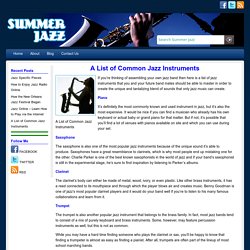
Piano It’s definitely the most commonly known and used instrument in jazz, but it’s also the most expensive. It would be nice if you can find a musician who already has his own keyboard or actual baby or grand piano for that matter. But if not, it’s possible that you’ll find a lot of venues with pianos available on site and which you can use during your set. Saxophone. Relaxing, Dinner, Study, Download. Jazz Stock Audio, Music And Sound, Royalty Free Jazz Audio Clips. History and Origins of Cajun Music - The Bayou Bandits ~ Sounds of Louisiana ~ The NorthEast's Premier Cajun-Zydecco Band. Dewey Balfa at left with Eli Stutes performing in the LSUE Acadian Center in 1979 a few months after the tragic death of Dewey's brothers, Rodney and Will, in a highway accident.

The Balfa Brothers have been described as the "quintessential Cajun band. " Vinesse LeJeune on fiddle and Alphonse "Bois Sec" Ardoin on accordion with Canray Fontenot behind them performing in the LSUE Acadian Center in 1979. Different versions of these musical subgenres like Cajun-country continue until this day, but one more development is of crucial importance in shaping Cajun music. In 1964, Gladius Thibodeaux, Louis "Vinesse" LeJeune, and Dewey Balfa (who joined as a last minute replacement playing guitar) accepted an invitation to represent Louisiana performing traditional Cajun music at the Newport Folk Festival. After their performance, they received a standing ovation. Which Musical Instruments Are Used in a Cajun Band? By Megan Romer Question: Which Musical Instruments are Used in a Cajun Band?
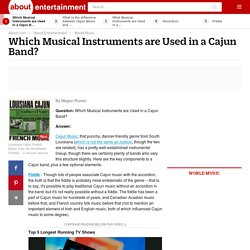
Answer: Cajun Music, that punchy, dancer-friendly genre from South Louisiana (which is not the same as zydeco, though the two are related), has a pretty well-established instrumental lineup, though there are certainly plenty of bands who vary this structure slightly. Audio & Video Clips on Louisiana Traditional Culture. The following is a list of audio and video clips featured on the Folklife in Louisiana website. 'Tit galop pour Mamou performed by Steve Riley and the Mamou Playboys Written by Dewey Balfa.
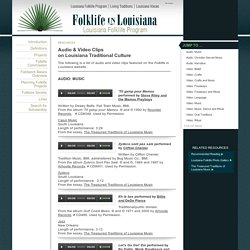
Flat Town Music, BMI. From the album 'Tit galop pour Mamou. ® and © 1992 by Rounder Records, # CD6048. Used by Permission. The Roots of Tejano and Conjunto Music. Arhoolie RecordsMusic Excerpts, Liner Notes, and Photos All music excerpts, liner notes, and photos on this page are the property of: Arhoolie Records, 10341 San Pablo Av., El Cerrito, CA 94530 The roots of Tejano and Conjunto music are as widespread and diverse, and run as deep, as the traditions, cultures and people which gave them life.

The main root is the music of Mexico with all its regional and class variations, its extraordinary range of songs and dances, and its social and religious musics ranging from the solo voice to the powerful sound of the bandas from Sinaloa to the highly stylized format of today's mariachis. The musical traditions of the Tejanos of South Texas and Norteños of Northern Mexico have been influenced not only by the mother country, Mexico, but also by their Anglo-American, African-American and immigrant neighbors like the Czechs, Bohemians, and Moravians as well as the Germans and Italians. The songs were contributed by both Mexican and Tejano composers. American Sabor. The term “Tejano” came to be applied in the 1980s to popular music rooted in South Texas.

Tejano does not describe a singular musical style; rather, it refers to a long process of musical hybridity. Como le Hare. The History of Salsa Music. By Tijana Ilich Updated September 11, 2016.
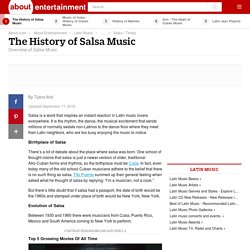
Salsa is a word that inspires an instant reaction in Latin music lovers everywhere. It is the rhythm, the dance, the musical excitement that sends millions of normally sedate non-Latinos to the dance floor where they meet their Latin neighbors, who are too busy enjoying the music to notice. Birthplace of Salsa There’s a lot of debate about the place where salsa was born. But there’s little doubt that if salsa had a passport, the date of birth would be the 1960s and stamped under place of birth would be New York, New York. Descriptions of Salsa Music Instruments ~ www.justsalsa.com. The Bongos ~ A pair of round drums held in the knees and struck with the hand.
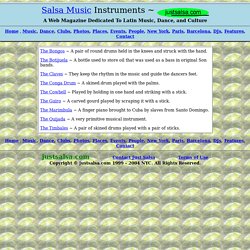
The Botijuela ~ A bottle used to store oil that was used as a bass in original Son bands. La Vida Es Un Carnaval - Celia Cruz. Mannycepeda - Paloma mia audio file. History of Reggae. Reggae is a term that was coined sometime close to 1960.
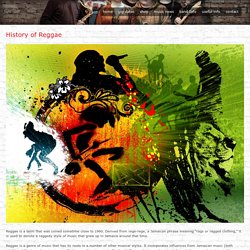
Derived from rege-rege, a Jamaican phrase meaning “rags or ragged clothing,” it is used to denote a raggedy style of music that grew up in Jamaica around that time. Reggae is a genre of music that has its roots in a number of other musical styles. It incorporates influences from Jamaican music (both traditional Mento and contemporary Ska), as well as American Rhythm & Blues, which was broadcast from high-powered stations in New Orleans and Florida in the early days of radio, and could be easily picked up in Jamaica. Reggae’s closest musical relations are Ska and Rocksteady, popular in Jamaica during the 1950s and early 1960s. Reggae evolved from these other genres, really coming into its own later that decade. Reggae shares many characteristics with Ska, such as a walking bass line with guitar and piano off-beats, but Ska is faster paced and also tends to incorporates jazz-influenced horn riffs.
Havel. Edward Havel Rhetoric of Reggae Research Paper Professor Alfred Snider (Tuna) Alexander Kofi Washington - PRAYER FOR HUMANITY audio file. Bob Marley - One Love. Nakai: Earth Spirit - Native American Music. Native American music. Native American music. The music of Native North Americans is primarily a vocal art, usually choral, although some nations favor solo singing. Native American music is entirely melodic; there is no harmony or polyphony, although there is occasional antiphonal singing between soloist and chorus.